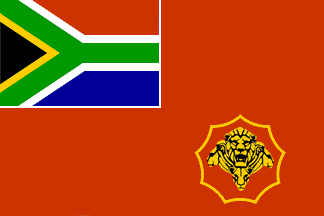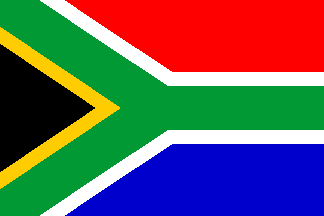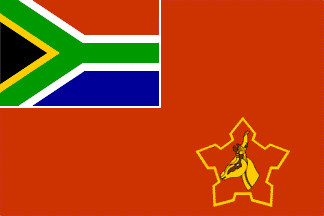 by Martin
Grieve, 10 Feb 2004
by Martin
Grieve, 10 Feb 2004
Last modified: 2005-09-10 by bruce berry
Keywords: army | castle | springbok |
Links: FOTW homepage |
search |
disclaimer and copyright |
write us |
mirrors
At a Retreat ceremony held on Friday 25 April 2003, the old
South African National Defence Force (SANDF) emblem, based on the Cape Castle outline,
was formally phased out. The old SANDF flag was lowered at the South African Air Force Gymnasium Parade Ground at 18h00. The new SANDF
emblem and flags were presented at a parade presided over by the Chief of the South African National Defence Force, General Siphiwe Nyanda, on
29 April 2003 at Defence Force Headquarters at Thaba Tshwane (formerly known as
Voortrekkerhoogte) near Pretoria.
The change is another milestone in the transformation process in the SANDF and sees the replacement of the
Cape Castle outline with a new
emblem. The new SANDF emblem incorporates a nine-pointed "Star" representing the warm sun of Africa and the nine provinces of
South Africa. The Star outline replaces the Castle outline and is also used in divisional emblems and flags to reflect a common corporate
identity coupled with a unique device for each Division. The four Services retain their respective traditional colours. The emblem also
reinforces the idea of military identity, authority and dignity.
With the exception of the badge in the fly, the new Army flag is identical in colour and overall design to its immediate predecessor (the
fifth adopted by the South African Army), which had been in use between
April 2002 and 25 April 2003. The 2002-2003 Army flag was the first to use new emblem comprising a lion's head surrounded by three lionesses
heads (the so-called "pride of lions") in gold in the centre of a red
shield in place of the Springbok head.
A new badge for the Army comprises the new nine-pointed star outline in yellow and in the centre
of which is army emblem of a lion's head surrounded by three lionesses' heads, also in yellow. The emblem is in the lower fly of the new Army
flag which was officially taken into use at a Defence Force parade held at Thaba Tshwane
near Pretoria on 29 April
2003.
Bruce Berry, 09 Jan 2004
Following the adoption of new Army badge and rank insignia in March 2000 which resulted in the Castle of Good Hope outline being dropped, a new flag for the South African Army was introduced in April 2002. The Army new emblem comprises three conjoined lions' heads above one lionesses head (the so-called "pride of lions") in gold in the centre of a red shield. This design was never registered with the heraldic authorities due to a perceived resemblance to the design used by India as a national emblem which is derived from the so-called Ashoka Pillar.
ay02.gif) by Martin Grieve, 23 Mar 2004
by Martin Grieve, 23 Mar 2004
Consequent upon the adoption of the new army emblem, two new Army flags were introduced in April 2002. The new army emblem replaced the
springbok and castle outline in the fly of the Army flag. The lions represent cohesion and the
ongoing transformation of the Army within the SANDF. The use of this flag was short-lived and it was replaced a year later
(see above)
following the adoption of the new 9 pointed star outline by the SANDF.
Bruce Berry, 23 Mar 2004
A new Army Office flag was also introduced in April 2002. This flag has a red field with the emblem superimposed over a pair of crossed swords
in the centre.
Bruce Berry, 23 Mar 2004
 by Martin Grieve, 24 Mar 2004
by Martin Grieve, 24 Mar 2004
On 11 November 1994 new South African military flags was adopted. Among these
was a new flag of the South African National Defence Force (SANDF) which has a:
green field with the national flag in the canton, and emblem in the lower fly
(two swords, one anchor, and wings). The Army is similar but with a red field
with a Springbok head emblem
Jaume Olle, 24 Nov 1996
The flags of the SANDF are as described above but the Airforce has a gold
eagle in castle emblem. All these flags are based on the designs used by the
former South African Defence Force (SADF). All the defence force flags have the
national flag in the canton and the the emblem of the particular service (Army,
Air Force etc) in the fly with the exeption of the naval ensign, which does not
display any emblem. A history of the Flags of the Union Defence Forces and of
the South African Defence Force 1912 - 1993 is available as SAVA Journal
2/93.
Bruce Berry, 26 Nov 1996
Following the adoption of the new national flag on 27 April 1994, a new flag design for the South African Army was approved by the Chief of the
South African National Defence Force on 11 August 1994, namely: "a
rectangular chilli red flag in the proportions of two to three; within the upper hoist quarter the national flag of the Republic of South
Africa, with a white fimbriation; and in the lower fly quarter the emblem of the South African Army, to wit; on an orange ground plan of
the Castle of Good Hope, with a gold border, a gold springbok head couped at the neck".
With the exception of the new national flag in the canton, this flag identical to that used previously
by the South African Army and was carried for the first time at a Defence Force parade held in Pietersburg on 11 November 1994.
(Source: Berry, B and Watson, E, "Flags of the South African Department of Defence - 1994 and
beyond", Paper presented at the XX International Congress of Vexillology, Stockholm, July 2003).
Bruce Berry, 24 Mar 2004
 by Martin Grieve, 24 Mar 2004
by Martin Grieve, 24 Mar 2004In 1973, the design of the South African Army flag was altered again. Uniform specifications as to the badge were manifest. The gold springbok head couped at the neck was centered on a gold outlined ground plan of the Castle of Good Hope. The ground plan was the same orange as before. Also, a fimbriation was added around th